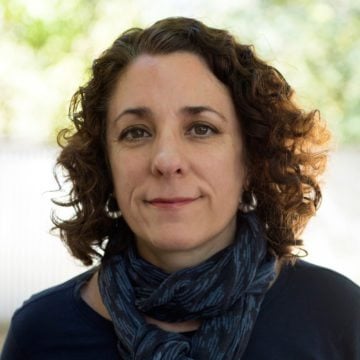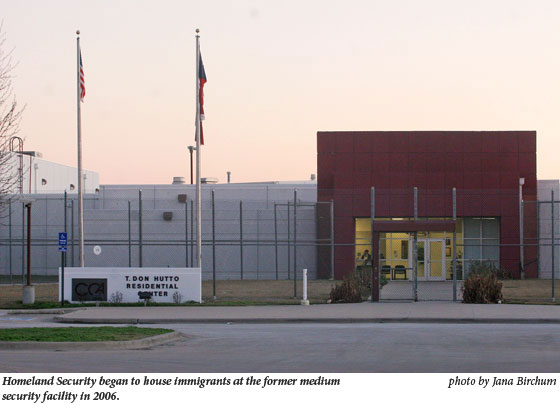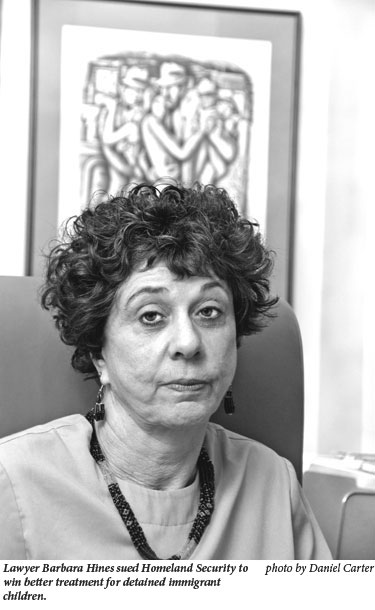Children of the State
The feds and Texas quarrel over custody of undocumented kids.

At a Texas airport, federal agents detain state child caseworkers and the undocumented children in their custody. The feds and the state bicker over care of a toddler trapped in a federal immigrant detention center. A foster child fails a mental health assessment and faces deportation as state workers beg the Department of Homeland Security to reconsider.
Across Texas, state and federal workers are clashing over children. Toughened federal rules designed to deter illegal immigration are creating unintended consequences for Texas’ Child Protective Services (CPS). Caseworkers along the Texas-Mexico border are struggling to navigate the new policies. It falls to them to care for undocumented children who have been removed from abusive families. Child welfare is a state issue. Immigration is a federal issue. State workers run the risk of five years in prison and several thousand dollars in fines from the federal government just for shepherding their young undocumented charges.
Sandra Rodriguez has watched the friction increase over the past five years. For more than a decade, Rodriguez has worked as what CPS calls a “border contact liaison.” She is responsible for trying to resolve immigration issues that arise between the state agency and federal immigration authorities. Rodriguez also oversees Region 11 for Child Protective Services and manages 54 caseworkers. Region 11 spans from Brownsville to Laredo and had 980 children in its care in the month of March 2008. She estimates that one percent of those children were undocumented.
Last year, the Border Patrol detained one of Rodriguez’s caseworkers for several hours at the McAllen airport. The woman had been transporting an undocumented teenager, an emergency removal from an abusive home. (More than 4 million people live along Texas’ border with Mexico but there are no residential treatment facilities or shelters for children who need special psychiatric care. Caseworkers must transport children who suffer extreme abuse or trauma to Houston, Dallas, or San Antonio.) Border Patrol agents took the teenager into custody despite court documents proving she was a ward of the state.
Rodriguez says she and her supervisor spent all day pleading with the feds to release their colleague and the teenager from Border Patrol custody. “We faxed every piece of court order and documentation that we had, but their decision was to take the child into custody,” she says.
The caseworker, who could have been charged with aiding an undocumented alien, was eventually released without penalties. The child in her custody, however, was turned over to Immigration and Customs Enforcement agents and sent to federal foster care in another state.
CPS has tried-to no avail-to negotiate a blanket agreement with U.S. Customs and Border Protection to allow the agency to transport undocumented children in their care through immigration checkpoints.
“I have children sleeping in my office and I can’t get them past the immigration checkpoints for the treatment they need,” Rodriguez says. “They are wards of the court and we are acting in good faith.”
The Observer contacted U.S. Customs and Border Protection and U.S. Immigration and Customs Enforcement to ask about their policies regarding undocumented children in CPS care. The conversations that followed offered just a small taste of the bureaucratic tangle that children and their state custodians must unravel when negotiating with Homeland Security.
Carl Rusnok, a spokesperson for ICE, referred the Observer to U.S. Customs and Border Protection. Daniel Doty, a public affairs officer with the border protection agency, said policies regarding undocumented children under CPS care are not public information and declined to discuss his agency’s relationship with Child Protective Services. Both men said they were not familiar with the McAllen case. CPS confirms that Border Patrol detained as many as three CPS caseworkers, and the children in their care last year.
For Rodriguez, what began as part-time additional duties helping CPS sort out immigration matters has become a more than full-time occupation requiring two assistants. “When this position started 12 to 13 years ago, it was on such a small scale. It was something you did to assist your colleagues,” Rodriguez says. “And then it just exploded. I would say in the last five years I noticed the increase with more questions about immigration and more calls coming in for assistance from child protective caseworkers in places like Lubbock.”
CPS documents released to the Observer show the number of undocumented children in state custody has increased, from 254 children in 2004 to 280 children in 2007.

At least 75 percent of those undocumented children come from Mexico, according to CPS documents. Texas has an agreement with Mexico regarding child welfare. Rodriguez works on a regular basis with the Mexican Consulate and the country’s child welfare agency, the Desarollo Integral de la Familia, to find missing relatives or to perform home studies to determine whether undocumented children in Texas should be placed with relatives in Mexico. Last year alone, caseworkers at the agency also cared for undocumented children from at least 23 other countries, including Vietnam, Germany, Canada, and Nigeria. Every week, Rodriguez works with foreign consulates to determine whether children in limbo should be placed in Texas’ foster care system or sent back to their home countries.
“People don’t understand that it takes a lot of time,” Rodriguez says of the extra job she is now expected to perform. “You have to keep these working relationships going with the consulates. None of us do this full time. It’s something extra we do in addition to our regular jobs.”
Rodriguez’s experience is not unique, according to Ilze Earner, an associate professor at the Hunter School of Social Work in New York who specializes in child welfare and immigration. Child welfare agencies all over the country are struggling to keep up with stepped-up enforcement against undocumented immigrants and the resulting increase in undocumented children caught in the system.
“Whenever you have an issue that crosses both of those policy streams you are going to have very complicated interpretations of whose jurisdiction it is. Neither system knows how to talk to the other,” Earner says.
One point of conflict is a new federal requirement that undocumented children in state care pass a mental health stability assessment as a precursor to obtaining residency in the United States. “A lot of our children have emotional trauma because of the abuse they have endured,” Rodriguez says. “Many of our children are under the care of a psychiatrist and the government will require a write-up from the psychiatrist regarding the child’s mental stability.”
Last year, one of her young charges failed the psychiatric evaluation. “The scary thing was they were going to deport this child to a country she’d never been to, where there was no one to receive her,” she says. “It was pretty harsh.”
Luckily, Rodriguez was able to appeal, and re-appeal, until federal immigration officials relented. “I haven’t had a child sent back yet-thank God,” she said.
Over the past three years, the Department of Homeland Security has expanded its detention facilities for children across the country. The increase in the number of undocumented immigrants detained has further contributed to conflicts over jurisdiction between the feds and state child welfare agencies. A glimpse into this ongoing struggle can be seen through e-mail exchanges over custody of a toddler housed at the federal T. Don Hutto Residential Center in Taylor, Texas.
The facility became the focus of litigation last year over poor living conditions for the undocumented families detained there. “The children were dressed in prison garb like their parents,” says Barbara Hines, the director of the University of Texas School of Law Immigration Law Clinic, who helped on the case. “The only children who weren’t wearing prison clothing were the infants, because they couldn’t find prison uniforms small enough.”
Hines says when she first toured the facility she found the families were depressed and crying and hadn’t been outside for days. They were counted seven times a day and children spent most of their time inside prison cells. “It was basically a prison model for children,” she says.
The state has no jurisdiction over the T. Don Hutto facility because it is not licensed under any state welfare regulations, according to Hines. “CPS doesn’t have regular access to this place.”
CPS documents obtained by the Observer show that in January 2007 the agency removed a two-year-old Honduran girl from the facility, which is run by Corrections Corporation of America. At least one detainee and a residential hall monitor at the facility accused the mother of abuse, according to documents from the Texas Department of Family and Protective Services, the umbrella agency over CPS. Witnesses said the mother, Maria, had placed a towel over her daughter Cynthia’s mouth to silence her, and had threatened to throw the child against the wall and kill her. (The Observer has changed the family’s names to protect their privacy.) The hall monitor, in documents identified as Ms. Albright, questioned Maria’s stability and said she was depressed:

“Ms. Albright informed that on December 6, Maria had to be taken to see a social worker due to having a ‘crying fit.’ Maria went from being uncontrollable to being ‘giddy.’ Ms. Albright stated Maria had been referred to see a social worker; however, the social worker can only see her once a week.”
CPS was asked to take custody of the child. Four months after receiving the child, Pamela Parker, director of Legal Policy at the Texas Department of Family and Protective Services, was still trying to clarify CPS’s right to legal custody of the child. Parker wrote in a letter to an Immigration and Customs Enforcement (ICE) official:
“It appears that ICE intended to and in fact did consent to DFPS taking custody of [Cynthia]. Without such consent, presumably this child would still be in ICE custody. To ensure there is no mistake regarding this issue, however, we request that you confirm no further consent is required…”
In an interview in April, Cynthia’s father said that Cynthia had been in CPS custody for more than a year. He and his wife had retained a lawyer and have been attending court hearings in an attempt to regain custody of their child. “We just want our daughter back, so that we can return to Honduras,” he says.
The number of Central American children in CPS care has risen recently, according to Sandra Rodriguez. She explains that many such families traveling north to look for work end up living in the border region. The interior immigration checkpoints 70 miles north prevent them from moving farther into the United States.It takes longer to communicate and reconcile paperwork with Central American consulates than with a neighboring country like Mexico.
“We don’t have Central American consulates here,” Rodriguez says of the border region. “They are either in New York or Houston. We don’t have any type of memorandum of understanding but we must notify them,” she says. “This is new territory for these consulates. There are not just adults now being smuggled, but also children being smuggled in to be reunited with their parents.”
Once CPS determines that a child will not be reunified with his or her family, the agency can apply to federal immigration authorities for Special Immigrant Juvenile status for the minor. This allows a child to become a legal permanent resident in the United States.
But states have little incentive to file the paperwork because they don’t receive any type of federal foster care reimbursement, says Christopher Nugent, an immigration lawyer with Holland & Knight in Washington, D.C. “The states are very resistant to take these children into their systems.”
If two-year-old Cynthia were to remain in state foster care, there is a chance she could reach 18 and still be undocumented and in legal limbo. No official numbers are kept, in Texas or nationwide, of how many children reach adulthood still undocumented. Statistics collected by the nonprofit Immigration Legal Resource Center show that the number of children nationwide who secure legal residency status nationwide is low. In 2000, 659 children received residency. In 2002, the last year for which data is available, only 521 children secured the status. (There are no accurate data for the number of undocumented children in state custody nationwide. According to CPS in 2007, just for the border region of Texas, there were 90 undocumented children.)

Another difficulty for state welfare agencies in securing residency for children in their custody is the rising cost of filing the paperwork. Rodriguez says the feds have increased the cost of filing by as much as 45 percent, an expense borne by the state. The slow pace and difficulty in obtaining residency puts children through extreme anxiety and depression as well, she says. Children cannot travel anywhere there might be an immigration checkpoint, and they cannot be adopted until their residency status is approved.
“They see other 16-year-olds going to a football game in Corpus and they can’t go. Or the entire foster family will go on vacation but they can’t go,” Rodriguez says. “They can’t get a driver’s license because they don’t have residency. And they can’t get a job like other 16-year-olds.”
Ilze Earner, who conducts immigration and child welfare trainings with federal and state agencies, says the two branches of government need to start a dialogue about the many complex questions surfacing around the intersection of child welfare and immigration.
For one thing, Earner says, the federal government needs to process residency paperwork faster, and make it more affordable for state welfare agencies. After all, she says, it is in the best interest of Texas to legitimize these children. “You don’t want undocumented people in your society. Not because they are bad people, but because they are off the radar and can’t participate in society,” Earner says. “You are creating a huge at-risk population.”
Despite the urgent need for more communication, there is little evidence that policymakers in Washington are moving in that direction.
“Our immigrat
on population is growing, but we are not catching up
ith the need,” Rodriguez says. “Not only Texas but a lot of states in the interior of the country are now feeling the impact of the immigrant population, and they are thinking, ‘How are we going to deal with this?'”


